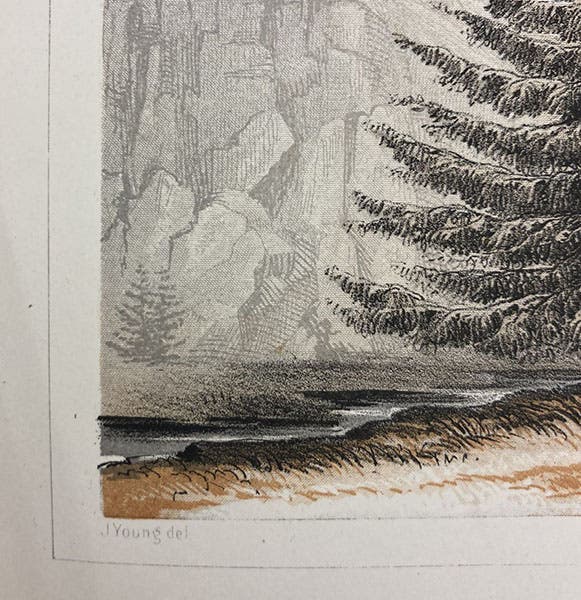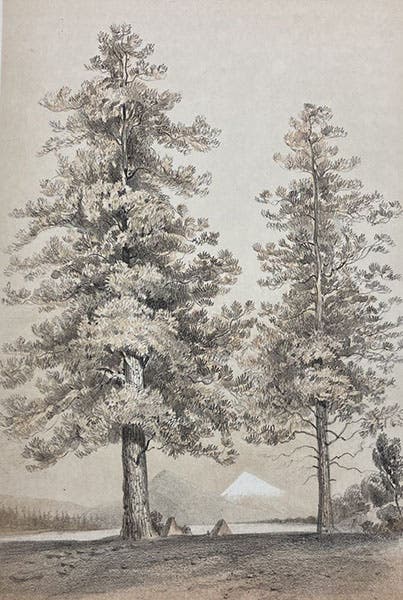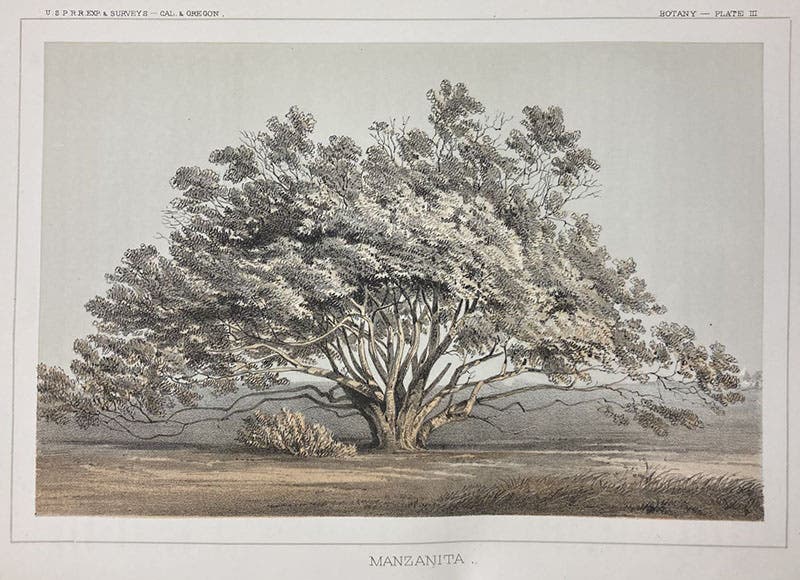Scientist of the Day - John J. Young
John J. Young, a topographic engineer and illustrator, died on Oct. 13, 1879, in Washington, D.C., of unknown age. We know very little about Young, and we only presume he was a topographical engineer, because he spent his entire life working for the Corps of Topographical Engineers. We don't have to presume he was an artist and illustrator, because we have many signed examples of his work, in various government publications about exploration of the West.
We begin with perhaps his best-known illustration, although it is usually attributed to the leader of the expedition, Joseph C. Ives, or the man who did the preliminary sketch, Baldwin Möllhausen. The lithograph, which is the frontispiece for Ives' Report about steaming up the Colorado River from its mouth, is dramatic and unexpected (a steamboat on the Colorado in 1857?), and as we can see from our first image, Young did the lithograph. He did many more lithographs for Ives’ book, six of which you can see in our post on Ives (where I nowhere showed Young's signature, which is why I opened with it here).
Young also accompanied John Macomb on an expedition that departed Santa Fe in 1859 and explored up into Colorado. One of the first places they visited was Shiprock, near the Four Corners area, which they called the Needles. The geologist, John S. Newberry, who was a pretty good artist himself, did the preliminary sketch, and Young did the lithograph, this time a chromolithograph, printed in color. We show it and Young's byline in our third and fourth images. Young did many other plates for Macomb's Report, as you can see in our post on Macomb and our post on Newberry. Macomb finished compiling his Report by 1860, but the Civil War delayed publication, and it did not appear in print until 1876.
The rest of the images in this post were taken from an expedition and a book that we have not mentioned before (I do not believe) in this series. In 1853, Robert Williamson led one of the 7 Pacific Railroad Surveys; his group roamed up and down California, looking for routes by which a railroad might cross the Sierras and the Mojave desert.

Detail of fifth image, chromolithograph of a Douglas fir, with signature of “J. Young del.,” Explorations and Surveys for a Railroad Route from the Mississippi River to the Pacific Ocean: Routes in California and Oregon, by Robert S. Williamson (Pacific Railroad Report no. 6), Botany plate 8, 1855 (Linda Hall Library)
Williamson's Report appeared as volume 6 of the 12-volume Pacific Railroad Reports in 1855. Since the expedition took along botanists and illustrators, it is not surprising that the final report included 10 tinted lithographs of great Western conifers and other impressive trees. The last five of these are signed by Young (and only Young); the first 5 are not signed, but since they are similar in style to the last five, they are presumed to be Young's handiwork. We show a Douglas fir (signed), a Ponderosa pine (signed), and a Manzanita (unsigned).

Ponderosa pine, chromolithograph by John J. Young, cropped to plate border, Explorations and Surveys for a Railroad Route from the Mississippi River to the Pacific Ocean: Routes in California and Oregon, by Robert S. Williamson (Pacific Railroad Report no. 6), Botany plate 4, 1855 (Linda Hall Library)
The principal authority on Western illustrators is Artists and Illustrators of the Old West, 1850-1900, by Robert Taft (Scribner's, 1953). It was Taft who discovered Young's death date, without which we would have had no hook on which to hang this anniversary. But Taft could find out little more concerning our man of the day. And there is no known portrait of Young. It is a good thing we have all these images to remember Young by.

Manzanita, chromolithograph, unsigned but presumed to be by John J. Young, in Explorations and Surveys for a Railroad Route from the Mississippi River to the Pacific Ocean: Routes in California and Oregon, by Robert S. Williamson (Pacific Railroad Report no. 6), Botany plate 4, 1855 (Linda Hall Library)
We displayed several of Young’s lithographs in an exhibition of long ago, Science Goes West (Linda Hall Library, 2004), for which we were not allowed to publish a catalog, print or digital. So it remains only a fond memory for me and my co-curator, Bruce Bradley. We really ought to remount the exhibition and give it a permanent record.
William B. Ashworth, Jr., Consultant for the History of Science, Linda Hall Library and Associate Professor emeritus, Department of History, University of Missouri-Kansas City. Comments or corrections are welcome; please direct to ashworthw@umkc.edu.





![Shiprock [the Needles], chromolithograph by John J. Young after J.S. Newberry, Report of the Exploring Expedition from Santa Fé, New Mexico, to the Junction of the Grand and Green Rivers, by J. N. Macomb, plate 10, 1876 (Linda Hall Library)](https://preview-assets-us-01.kc-usercontent.com:443/9dd25524-761a-000d-d79f-86a5086d4774/daf20516-24f1-4706-a5b9-26bff0e0a40f/young4.jpg?w=759&h=600&auto=format&q=75&fit=crop)






